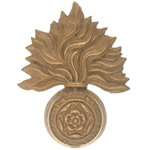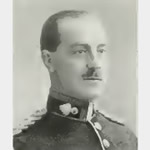Commemorated: | |||
| 1. Memorial: | Le Touret Memorial | Panel 6. | |
| 2. Book: | The (1921) Masonic Roll of Honour 1914-1918 | Pg.135 | |
| 3. Memorial: | The (1940) Scroll - WW1 Roll of Honour | 57D GQS | |
Awards & Titles: | Mentioned in Despatches | ||
Family :
Son of Philip John and Johanna Albertina Steele, of Grange Rd., Toorak, Melbourne, Victoria, Australia.Service Life:
Campaigns:
- The First World War 1914-1918, World-wide.
| Unit / Ship / Est.: 4th Battalion Royal Fusiliers |
4th Battalion August 1914 : in Parkhurst (Isle of Wight). Part of 9th Brigade, 3rd Division. Landed at Le Havre 13 August 1914. |
| Action : The Battle of La Bassee |
The battle of La Bassee, 10 October-2 November 1914, was part of the Race to the Sea, the series of battles that established the line of the Western Front from the Aisne to the North Sea. The BEF had been swept up in the great retreat that had ended at the first battle of the Marne.
Once the situation east of Paris had stabilised, it was decided to move the BEF north to Flanders. This would greatly simplify the problems of supplying the British army in France by bringing the army closer to the channel ports. It was also still believed that it would be possible to get around the right flank of the German armies that had marched south to the Marne, and Flanders was seen as a good area for cavalry. II Corps of the BEF arrived at Abbeville by train on 8-9 October. It was then decided to send it north east towards La Bass?e, to the left of the French lines. Sir John French was planning a general offensive along what would become the British line, aimed at recapturing Lille and perhaps even breaking through into Belgium. The battle really began on 12 October.
On that day II Corps was ordered to advance east to a line running north from Givenchy. The British advance was opposed by four German cavalry divisions from I and II cavalry corps. It would take three days to reach the line originally intended to be the target for the fighting on 12 October. During those days II Corps suffered 2,000 casualties, half of them on the first day. Givenchy was captured on 12 October, but lost on the next day. On 15 October the British learnt that the German cavalry corps were about to withdraw, but not that they were about to replaced by the infantry of VII corps. General Smith-Dorrien ordered a new offensive, this time to the south east. Its aim was to outflank the German troops attacking the French lines to the south. The attack began on 16 October, and made slow progress. Givenchy was recaptured, but the advance failed to reach Le Bass?e (the official history records that British troops were not to be this close to Le Bass?e for four years). II Corps suffered another 1,000 casualties during this phase of the battle. A key element in the failure of the offensive was the arrival of German reinforcements. XIII corps took over part of the line held by VII corps, thickening the German lines. Another Allied attack was planned for 19 October. The only success during this attack would lead to tragedy. The 2nd battalion of the Royal Irish captured Le Pilly, a village on Aubers Ridge, but the rest of the advance failed. The Royal Irish were dangerously isolated, but before the order to retreat could reach them they were surrounded by the Germans. Of nearly 900 men only 300 survived to surrender to the Germans.
On 20 October the Germans went onto the attack. A major offensive was launched all along the German line from Arras to the sea. Fortunately, that day II corps had halted their offensive and been ordered to hold their line. German attacks on 20 and 21 October were repulsed, but Smith-Dorrien decided to retreat to a stronger defensive line that had been prepared behind the front line. Although work had begun on preparing this new line, it was still very basic compared to the trench lines that would follow. Very little barbed wire was available, all of it taken from local fields, while there had not been the time or labour to dig proper trenches. What the line did have in its favour was that its line had been carefully selected by the engineers. The new line began close to the right wing of II corps, but as it ran north the gap increased, until at its northern end it was two miles behind the most advanced portions of the line. The retreat was carried out over the night of 22/23 October, and caught the Germans by surprise. 23 October was thus a quiet day. The same period also saw the arrival of the Lahore Division of the Indian corps to the rear of the line. During the rest of the battle Indian troops would play an increasingly important role in the fighting, until on 30 October the Indian Corps would relieve II corps. By then the fighting had largely died down.
The German attack was renewed on 24 October along the entire Sixth Army front. A daylight attack failed to make any headway. It was followed by an attack at dusk, which did break into the British trenches at two places, but local counterattacks restored the situation. A second night attack, on 26/27 October, caused more problems. Part of the British line was broken, and the village of Neuve Chapelle captured. This created a shallow salient in the British line. At this early period in the war the buildings of Neuve Chapelle still survived, making the village a dangerous strong point that threatened the British lines. A major counter attack was launched on 28 October, but failed to retake the village. On 29 October the village was reported to have been evacuated, but later in the day German troops used the ruins as cover for their last major attack of the battle.
After the failure of the attack on 29 October, the Germans moved much of their heavy artillery north towards Ypres, where it took part in the battle of Gheluvelt. This marked the end of the serious fighting at Le Bass?e, although small scale attacks continued for some days. On 30 October the Indian corps began to replace II corps in the line. On the morning of 31 October command of the sector was officially handed over to General Sir James Willcocks, commander of the Indian Corps. II corps had suffered 14,000 casualties during October 1914, but despite these heavy losses and the constant fighting since 12 October, the BEF could not afford to give the corps a proper rest. As they left the front line the men of II corps turned north towards Ypres.
Detail :
CAPTAIN FREDERICK WILBERFORCE ALEXANDER STEELE, 4th BATTN. ROYAL FUSILIERS, who was killed in action on the 26th or 27th October, 1914, was the eldest son of Mr. and Mrs. Philip J. Steele, of Normanhurst, Kew, Melbourne, Australia. He had at first been reported, in December 1914 as wounded and missing, and had been present at the Battle of Mons. Our first clue about Frederick STEELE was a record of him being on the electoral role in Victoria, Australia in 1914. This did not seem too helpful as it seemed likely to be incorrect given that the Frederick STEELE that we were tracking was an officer in a Regular Battalion and not likely to have been in Australia - however this record was proved correct. He was a member of the MCC - not the Marylebone Cricket Club but the Melbourne Cricket Club in Victoria and he is mentioned in a publication by that club in 1998 as follows; Born in 1885, the eldest son of Philip John and Albertine Steele, of “Normanhurst”, Denmark Street, Kew. Educated at Melbourne Grammar School 1899-1901. Lieutenant in the Australian Field Artillery in 1905 before transferring to the British Army and serving at Jubbulpore in India. In August 1914, he went to France with the 4th Battalion of the Royal Fusiliers. Served at Mons. A few weeks later he was wounded, but quickly rejoined the Battalion. He was killed while leading an attack at Neuve Chapelle on October 26, 1914. Mentioned In Despatches. He was the first MCC (Melbourne Cricket Club) Member to lose his life in the War. So he was an Australian serving in the British Army, and he was twice Mentioned in Despatches. The 4/Royal Fusiliers were involved in trying to stem the German breakthrough at Neuve Chapelle and then in the improvised counter attack that regained the village on 26th October 1914. Nearly 200 O/R and 8 officers of a much depleted battalion were casualties (including Frederick STEELE). The following is an extract from a letter written by Captain Steele's Commanding Officer: He was leading a night attack through a village when he was shot, and death appears to have been instantaneous. Sergeant Woodcock was close by when your son was hit, and, though he got to him at once, he says he was undoubtedly dead. I cannot say how highly we all thought of your son. He was equal to the best officer I have ever met, and I had undoubted confidence in him. I had already recommended him for special distinction, and hope that some mark of appreciation in the shape of a posthumous honour may yet be conferred on him. I also brought him personally to the notice of Sir John French, who congratulated him on his distinguished service. And the Adjutant of his battalion wrote: Your son was one of the very best officers I have ever seen, always cheery and energetic, and most capable. The Colonel, I know, had the very highest opinion of him. For his services in the war Captain Steele was mentioned in Sir John French's Despatches of the 5th October, 1914, and 14th January, 1915. Captain Steele, who was unmarried, was a member of the Junior Army and Navy Club. His three brothers all served in the war. He was born on the 12th September, 1885, and was educated at the Church of England Grammar School, Melbourne, and at Messrs. Carlyle and Gregson's, London. He received his commission in the Royal Fusiliers from the Commonwealth Military Forces in July, 1907, becoming Lieutenant in April, 1910. His promotion to Captain, to date from the 13th December, 1914, was gazetted on the 1st March, 1915. Sources; MELBOURNE CRICKET CLUB: MCC HONOUR ROLL- Alf Batchelder 1998. Official History Military Operations France & Belgium 1914 Vol II
Masonic :
| Type | Lodge Name and No. | Province/District : |
|---|---|---|
| Mother : | Alma No. 3534 E.C. | Middlesex |
Initiated | Passed | Raised |
2nd May 1910 | 6th June 1910 | 4th July 1910 |
Source :
The project globally acknowledges the following as sources of information for research across the whole database:
- The Commonwealth War Graves Commission
- The (UK) National Archives
- Ancestry.co.uk - Genealogy, Family Trees & Family History online
- ugle.org.uk - The records of the United Grand Lodge of England including the Library and Museum of Freemasonry
Additional Source:
- Founder Researchers : Paul Masters & Mike McCarthy
- Researcher : Bruce Littley

